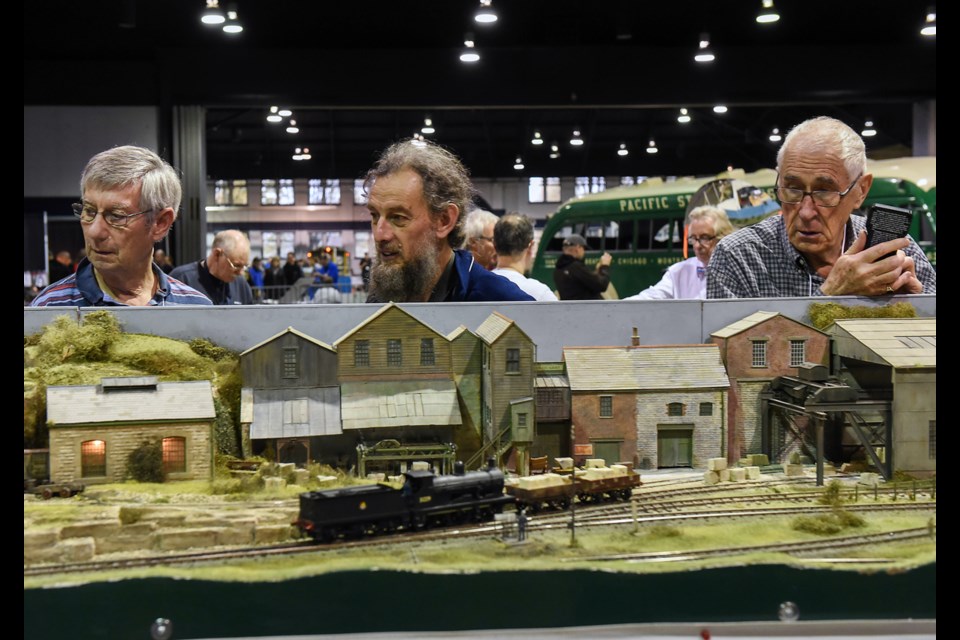The relationship between man and machine can be a complex one, especially if your name is Dan Huberman.
He may be unknown to those outside the world of model trains, but the people behind the manufacturing of Canadian railcars — the actual cars that trundle goods between this country’s coasts — know exactly who he is.
Every time one of the builders of these cars makes a change, whether for practical or esthetic purposes, they hear from Huberman who in turn modifies the mold for the rail car model. Take the quintessential Canadian coal car, for example. Four different companies built their own versions so Huberman’s model company, North American Railcar Corporation, mirrored each one and their various characteristics on an N-scale and the larger HO-scale. Scrutinizing train spotters can choose from such tiny differentiating features such as 17 or 19 side posts or a double or elongated hole on the bolter-roping plate. It’s curious magnifying glasses are not included with each model railcar Huberman sells.
In the Prairies, grain cars in a grass-green and white colour scheme are replacing the old rust-coloured and tan versions with their detailed yellow pin-striping on the rail landscape. That’s Huberman’s idea, which came about when he contacted the Saskatchewan government eight years ago to request permission to build a replica model.
“I told them they were complicated and hard to paint on a model with the ladders and other details, and they said, ‘Try that on a one-to-one scale!’ Twenty years ago when they did the painting, it wasn’t done with efficiency. It was difficult with lots of pinstripes,” Huberman said from his booth at the Vancouver Train Expo held this past weekend at the PNE Forum. “I said, ‘the Saskatchewan Roughriders of the CFL have already figured it out for you. Use the green of the jersey and the word ‘Saskatchewan’ in white and an orange tiger lily. Make the car all one colour, make the message simple. The cars are a traveling billboard for the people of Saskatchewan.’”
While the new colour scheme made life easier for both real-life and model painter, not to mention its practical use of staving off corrosion on the former, it amounted to just one tiny detail less to worry about for Huberman who built his company’s reputation on preciseness. North American Railcar Corporation started 15 years ago when Huberman, who knew there was a lack of accurate Canadian model trains and cars, went to China to visit model manufacturers with the priority of accuracy over cost.
“What had been going on for many years is you would go to a train store and you’d see a nice Canadian Pacific boxcar or Canadian National car and all that they would do is slap a Canadian Pacific or Canadian National sticker on a car,” said Huberman. “Canadians always used to get the short end of the stick because they could not get cars that were the correct cars.”
After producing the Hawker Siddeley grain car, next came the 1970s era “Trudeau” hopper, which was built after former Prime Minster Pierre Trudeau requested more grain cars be produced as there weren’t grain movement from the Prairies.
Train spotters recognize the Trudeau-era Hawker Siddeley-built cars, which are still on tracks in Canada, the United States and Mexico, by the alternating side to wide side panel design. Which, of course, is represented on Huberman’s models.
It’s not just the attention to detail and historical importance of the trains that’s important to model railroaders — there’s also the nostalgia factor.
“I sometimes get customers coming into our store or our warehouse in Surrey and they say, ‘I’m thinking about getting a model train,’ and I’ll say, ‘What do you picture in your mind?’” said Huberman. “They’ll say, ‘Well, I can remember being with my father in downtown Vancouver and seeing steam trains.’ Or, ‘My father worked for CP Rail and I remember seeing all those coal cars in West Vancouver.’”
Or, if they’re like the woman who stopped by the booth at the busy Train Expo, which was held in Vancouver for the first time after outgrowing a Burnaby community centre, you’ll pick the “pink car,” which is a model of a three-bay covered potash hopper built by National Steel and, of course, available exclusively through Huberman’s company. Because who wouldn’t want a model railcar of the world’s largest producer of potash?
rvblissett@gmail.com
@rebeccablissett



